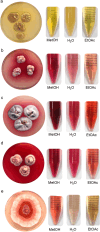Antarctic fungi produce pigment with antimicrobial and antiparasitic activities
- PMID: 38492163
- PMCID: PMC11153455
- DOI: 10.1007/s42770-024-01308-y
Antarctic fungi produce pigment with antimicrobial and antiparasitic activities
Abstract
Natural pigments have received special attention from the market and industry as they could overcome the harm to health and the environmental issues caused by synthetic pigments. These pigments are commonly extracted from a wide range of organisms, and when added to products they can alter/add new physical-chemical or biological properties to them. Fungi from extreme environments showed to be a promising source in the search for biomolecules with antimicrobial and antiparasitic potential. This study aimed to isolate fungi from Antarctic soils and screen them for pigment production with antimicrobial and antiparasitic potential, together with other previously isolated strains A total of 52 fungi were isolated from soils in front of the Collins Glacier (Southeast border). Also, 106 filamentous fungi previously isolated from the Collins Glacier (West border) were screened for extracellular pigment production. Five strains were able to produce extracellular pigments and were identified by ITS sequencing as Talaromyces cnidii, Pseudogymnoascus shaanxiensis and Pseudogymnoascus sp. All Pseudogymnoascus spp. (SC04.P3, SC3.P3, SC122.P3 and ACF093) extracts were able to inhibit S. aureus ATCC6538 and two (SC12.P3, SC32.P3) presented activity against Leishmania (L.) infantum, Leishmania amazonensis and Trypanossoma cruzii. Extracts compounds characterization by UPLC-ESI-QToF analysis confirmed the presence of molecules with biological activity such as: Asterric acid, Violaceol, Mollicellin, Psegynamide A, Diorcinol, Thailandolide A. In conclusion, this work showed the potential of Antartic fungal strains from Collins Glacier for bioactive molecules production with activity against Gram positive bacteria and parasitic protozoas.
Keywords: Pseudogymnoascus; Talaromyces; Antarctic; Antimicrobial molecules; Natural pigments.
© 2024. The Author(s) under exclusive licence to Sociedade Brasileira de Microbiologia.
Conflict of interest statement
The authors declare no competing interests.
Figures


Similar articles
-
Terrestrial and marine Antarctic fungi extracts active against Xanthomonas citri subsp. citri.Lett Appl Microbiol. 2018 Jul;67(1):64-71. doi: 10.1111/lam.12890. Epub 2018 May 7. Lett Appl Microbiol. 2018. PMID: 29604211
-
Cultivable fungi present in Antarctic soils: taxonomy, phylogeny, diversity, and bioprospecting of antiparasitic and herbicidal metabolites.Extremophiles. 2018 May;22(3):381-393. doi: 10.1007/s00792-018-1003-1. Epub 2018 Jan 13. Extremophiles. 2018. PMID: 29332141
-
Fungal Community in Antarctic Soil Along the Retreating Collins Glacier (Fildes Peninsula, King George Island).Microorganisms. 2020 Jul 29;8(8):1145. doi: 10.3390/microorganisms8081145. Microorganisms. 2020. PMID: 32751125 Free PMC article.
-
The hidden rainbow: the extensive biotechnological potential of Antarctic fungi pigments.Braz J Microbiol. 2023 Sep;54(3):1675-1687. doi: 10.1007/s42770-023-01011-4. Epub 2023 Jun 8. Braz J Microbiol. 2023. PMID: 37286926 Free PMC article. Review.
-
The colorful fungi of the Chilean forests: Production, chemical characterization and possible applications of their pigments.Adv Appl Microbiol. 2024;128:1-40. doi: 10.1016/bs.aambs.2024.05.003. Epub 2024 Jun 19. Adv Appl Microbiol. 2024. PMID: 39059841 Review.
Cited by
-
Variability of microbiomes in winter rye, wheat, and triticale affected by snow mold: predicting promising microorganisms for the disease control.Environ Microbiome. 2025 Jan 11;20(1):3. doi: 10.1186/s40793-025-00665-x. Environ Microbiome. 2025. PMID: 39799378 Free PMC article.
-
Lipid Production in Cultivable Filamentous Fungi Isolated from Antarctic Soils: A Comprehensive Study.Microorganisms. 2025 Feb 25;13(3):504. doi: 10.3390/microorganisms13030504. Microorganisms. 2025. PMID: 40142397 Free PMC article.
References
-
- Rosa LH, Zani CL, Cantrell CL, Duke SO, Van Dijck P, Desideri A. Fungi in Antarctica: diversity, ecology, effects of climate change, and bioprospection for bioactive compounds. In: Rosa LH, editor. Fungi of Antarctica: diversity, ecology and biotechnological applications. 1. Springer; 2019. pp. 1–17.
-
- Mitrović T, Stamenković S, Cvetković V, Nikolić M, Tošić S, Stojičić D. Lichens as source of versatile bioactive compounds: an open window for green therapy against diverse cancers. Biol Nyssana. 2011;2(1):1–6.
MeSH terms
Substances
Grants and funding
LinkOut - more resources
Full Text Sources
Miscellaneous

